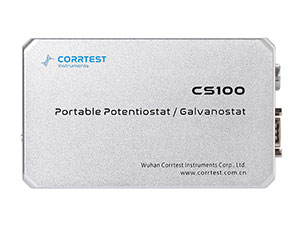Product Introduction
.png)
The small and convenient potentiostat can be used for performance testing of battery materials in the glove box;
Ultra-low detection limit of heavy metal ions, suitable for water quality testing in environmental protection;
High current accuracy, suitable for small current detection in biosensor;
Comprehensive functions, can be used for the active ingredients detection in food and drug field;
Easy to carry, suitable for bridge corrosion and soil corrosion measurements Overview
The CS100 portable potentiostat is composed of DDS digital signal synthesizer, constant potential control, dual-channel high-speed 16bit/high-precision 24bit AD converter. The built-in DDS and dual-channel signal correlation integral circuit improves the measurement accuracy of AC impedance. The EIS frequency range is 10μHz~1MHz. It can automatically perform electrochemical impedance test under open circuit potential or any DC bias voltage. Built-in DC offset compensation circuit can effectively improve the measurement accuracy of AC signals. The amplitude of the exciting sine wave can be set between 0 ~±2.5V. The EIS data format is compatible with ZView, and ZView can be directly used for impedance spectrum analysis. CS100 potentiostat can also output sine wave, square wave, triangle wave, sawtooth wave, pulse wave, etc., and the output frequency is 0~100KHz. The command control and data analysis of the CS100 portable potentiostat are realized through the CS Studio software. The software has multi-coordinate graphic display and zooming, data/graphic storage/printing, and interactive help. The software has techniques for materials and corrosion electrochemistry, including automatic or manual reverse sweep of passivation curve, electrochemical reactivation method, solution resistance (IR drop) measurement and compensation. CS Studio software also has a complete data analysis function, which can achieve the volt-ampere curve smoothing, the peak height and area integration, and the electrochemical parameters abalysis of the polarization curve, including polarization resistance Rp, Tafel slope ba, bc, and corrosion current density icorr, corrosion rate calculation, etc., noise resistance Rn and power spectrum can also be calculated, and the graph can be copied to other files in vector mode.
Specifications
Communication: USB/BluetoothPower supply: built-in li-battery This email address is being protected from spambots. You need JavaScript enabled to view it. / USB port charge
Size / weight:150mm x 90mm x 30mm, 500g
Support 2-, 3-or 4-electrode system
Potential control range: ±10V
Maximum current: ± 45mA
Compliance voltage: ±12V
Potential accuracy: 0.1%× full range
Minimum potential resolution: 10mV
Current accuracy: 0.1%× full range
Minimum current resolution: 100fA
Potential range: 3 (±2.5V, ±5V, ±10V)
Current range: 200pA~50mA, 10 ranges
(200pA, 2nA, 20nA, 200nA, 2uA, 20uA, 200uA, 2mA, 20mA, 50mA)
Reference electrode input impedance: 1013Ω||8pF
EIS frequency range: 10μHz ~ 1MHz
AC amplitude: 0~±2.5V
Signal response bandwidth: 1MHz
Max. acquisition rate:150,000 data points/s
CV and LSVscan rate: 0.001mV~ 10V/s
Techniques
Stable polarization - Open Circuit Potential (OCP)
- Potentiostatic (I-T curve)
- Galvanostatic
- Potentiodynamic (Tafel plot)
- Galvanodynamic (DGP)
- Multi Potential Steps
- Multi Current Steps
- Potential Stair-Step (VSTEP)
- Galvanic Stair-Step (ISTEP)
- Chronopotentiometry (CP)
- Chronoamperametry (CA)
- Chronocaulometry (CC)
- Linear Sweep Voltammetry (LSV)
- Cylic Voltammetry (CV)
- Staircase Voltammetry (SCV)
- Square Wave Voltammetry (SWV)
- Differential Pulse Voltammetry (DPV)
- Normal Pulse Voltammetry (NPV)#
- Differential Normal Pulse Voltammetry (DNPV)
- AC Voltammetry (ACV)
- 2nd harmonic AC Voltammetry (SHACV)
- Fourier Transform AC Voltammetry (FTACV)
- Differential Pulse Amperometry (DPA)
- Double Differential Pulse Amperometry (DDPA)
- Triple Pulse Amperometry (TPA)
- Integrated Pulse Amperometric Detection (IPAD)
- Potentiostatic Stripping
- Linear Stripping
- Staircase Stripping
- Square Wave Stripping
- Differential Pulse Voltammetry Stripping
- Normal Pulse Voltammetry Stripping
- Differential Normal Pulse Voltammetry Stripping
- EIS vs Frequency (IMP)
- EIS vs Time (IMPT)
- EIS vs Potential (IMPE)(Mott-Schottky)
- Cyclic polarization curve (CPP)
- Linear polarization curve (LPR)
- Electrochemical Potentiokinetic Reactivation (EPR)
- Electrochemical Noise (EN)
- Zero resistance Ammeter (ZRA)
- Battery Charge and Discharge
- Galvanostatic Charge and Discharge (GCD)
- Potentiostatic Charging and Discharging(PCD)
- Potentiostatic Intermittent Titration Technique(PITT)
- Galvanostatic Intermittent Titration Technique(GITT)
- Data Logger
- Electrochemical Stripping/ Deposition
- Bulk Eletrolysis with Coulometry (BE)
- Rs measurement


















